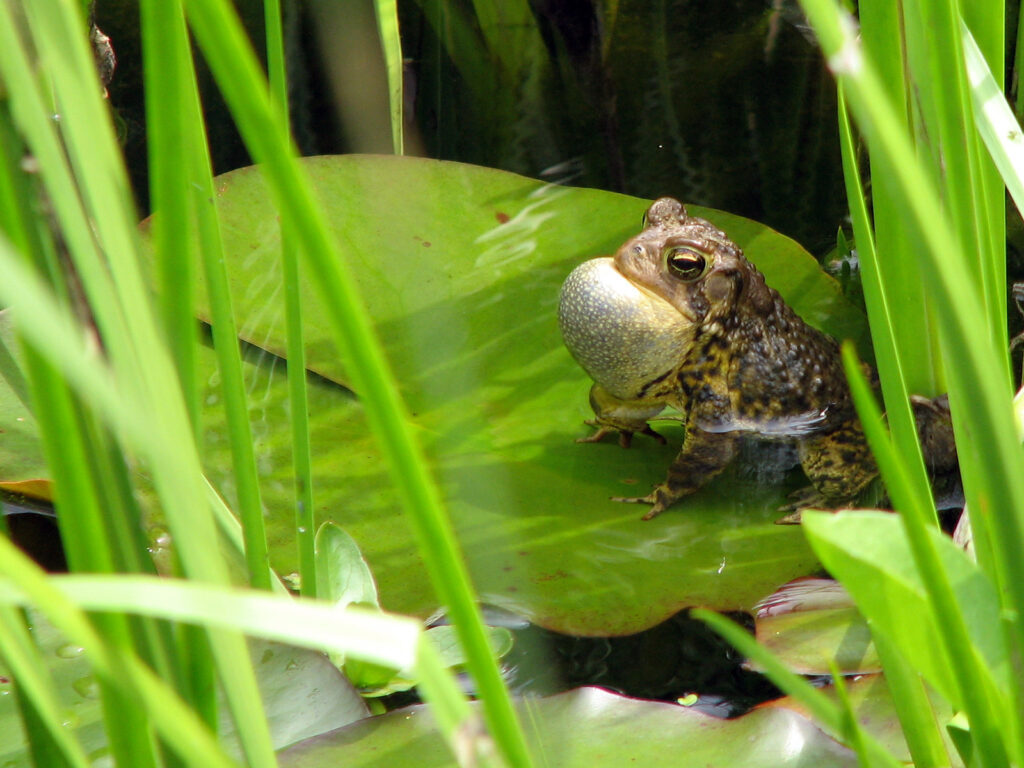FrogWatch USA
I participated in FrogWatch USA from 2004 through 2011. At first, it was sponsored by National Wildlife Federation. Then, it was co-hosted by the Association of Zoos and Aquariums (AZA).

It’s still sponsored by AZA, but now, apparently, only people who participate in the training can submit data. Perhaps there were too many errors in data collection made by untrained people since the requirements are a little different than most citizen science experiments. One difference is that you wait until night and then listen for calls.
I’ll continue to collect my own data, but won’t be participating officially any longer.
History of toads’ mating calls in our yard
Here’s when I first heard them singing each year:
| Mar 15-21 | Mar 22-31 | Apr 1-6 | Apr 7-13 | Apr 14-20 | Apr 21-> |
| ’12 | ’09 | ’04 | ’06 | ’05 | ’11 |
| ’07 | ’13 | ’08 | ’20 | ||
| ’10 | ’14 | ’19 | |||
| ’16 | ’15 | ||||
| ’21 | ’17 | ||||
| ’22 | |||||
| ’23 | |||||
| ’24 |
The exact dates
- 2004 – 4/05
- 2005 – 4/16
- 2006 – 4/10
- 2007 – 4/03
- 2008 – 4/17
- 2009 – 3/28
- 2010 – 4/02
- 2011 – 4/24 (Could have been earlier – I was late in getting started)
- 2012 – 3/18 – the earliest ever!
- 2013 – 4/10
- 2014 – 4/13
- 2015 – 4/13
- 2016 – 4/3
- 2017 – 4/10
- 2018 (didn’t note the date)
- 2019 – 4/18
- 2020 – 4/29 – the latest ever!
- 2021 – 4/6
- 2022 – 4/13
- 2023 – 4/12
- 2024 – 4/9
Here are the number of batches of toad eggs we’ve observed:
- 2004 – 3 batches around 4/20
- 2005 – 5 batches between 4/18 and 5/10
- 2006 – 4 batches between 4/15 and 5/13
- 2007 – 4 batches between 4/24 and 5/26
- 2008 – 5 batches between 4/18 and 4/20
- 2009 – 6 batches between 4/19 and 4/25
- 2010 – 3 batches between 4/08 and 6/01
- 2011 – 2 batches on 4/26
- 2012 – (I didn’t record data that year)
- 2013 – 3 batches between 4/18 and 4/19
- Since then, we’ve had multiple batches of eggs – on the order of 5-7 batches or more
The types of data I collected
Since I’m monitoring only my own ponds, I know who’s calling — American toads and (previously) green frogs — since I see and hear them all day, at least during their mating season, which is the only time they make these sounds.
One year and one year only we also had one spring peeper. They’re small and not easily seen, but their voice makes up for what they lack in size. “Peeping” sounds so gentle, but it was one of the most intense sounds we’ve ever heard in our yard. We hope he comes back some year (though more than one or two peepers might be too many in our small yard …)
Of course, if I were to monitor a natural area, there could be a greater variety to be identified by sound only, since they ask that you monitor after sundown. The FrogWatch website helps you identify the sounds you hear.
The bonus in participating in this citizen science project is that you become tuned in to their sounds, and in the case of the American toad this is especially appealing. In fact, we had heard their song before we knew what it was. We never would have guessed that the musical trill could have been emanating from our curmudgeonly-looking toads! Hearing our first toads singing has become the true sign of spring for us.
When we participated, we collected information on:
- how many calls (a single call, more than one, a whole chorus etc.) of each type of frog
- how much the wind was blowing, using an easily understandable scale
- the current temperature
- whether it was raining during the 3-minute listening period
- whether it was raining in the previous 48 hours
One lesson I’ve learned is to maintain my own set of records. When ownership of the FrogWatch project was transferred to the AZA, I lost all the data I had submitted when the NWF was in charge. Fortunately, I still have my notes, but not as organized as they were when I was able to access my records online.
Reflections
If we can discover the meaning in the trilling of a frog, perhaps we may understand why it is for us not merely noise but a song of poetry and emotion.
~ Adrian Forsyth
